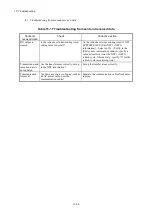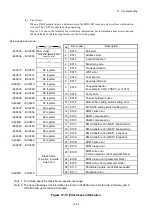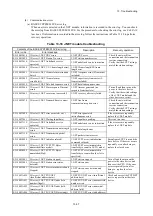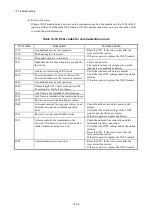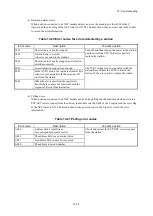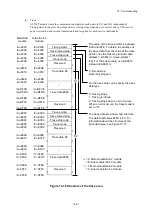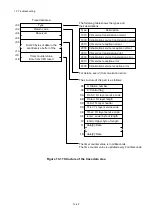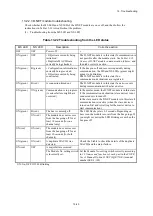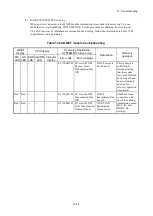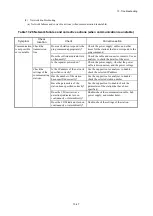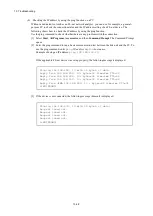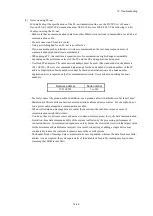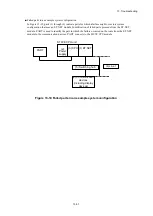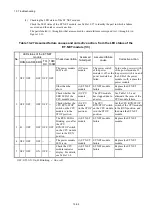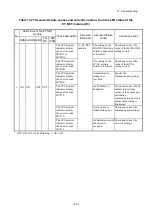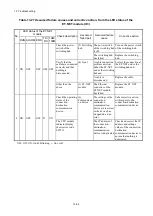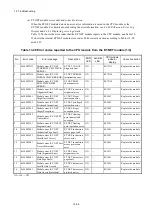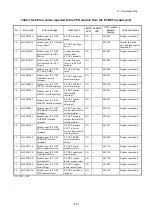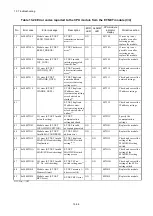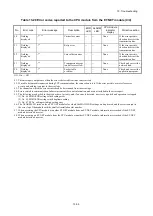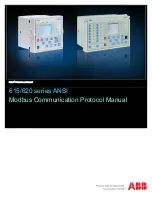
13. Troubleshooting
13-44
(2) Troubleshooting from the cabling and the communication settings
The following describes the causes of D.NET module communication failures. Take corrective action
according to the relevant causes.
Table 13-23 Causes of D.NET module communication failures
No.
Cause of communication failure
Corrective action
1
Only one D.NET module exists in the network. (If no
other nodes exist, communication is not possible.)
This is not an error. Connect other nodes to the
network, and turn on the power to the nodes.
Communication will then start normally.
2
Multiple nodes exist in the network, but transfer
speed is inconsistent among the nodes.
Use the same transfer speed setting for all nodes in the
network.
3
Multiple nodes exist in the network, but the network
load is extremely high, and transmissions over the
network are not possible. (This situation might occur
when the MAC ID priority of the local node is lower
than that of the other nodes. Smaller MAC IDs have
higher priority.)
Reduce the network load, such as by choosing a longer
transmission cycle for each node or reducing the
number of nodes.
4
Network power is not being supplied. The LQE770-E
does not require a power supply, but third-party
DeviceNet products require it.
Connect network power to the devices that require it.
5
Network power is being supplied, but is of
insufficient capacity.
Reconsider the network power capacity by referring to
3.3.5 Communication power supply location
considerations
in the
S10VE User's Manual Option
D.NET (LQE770-E)
(manual number SEE-1-103).
6
The cable length exceeds the maximum limit.
Reconsider the cable length by referring to
3.3.4
Restriction on the cable length
in the
S10VE User's
Manual Option D.NET (LQE770-E)
(manual number
SEE-1-103).
7
A termination resistor is not connected.
Connect a termination resistor according to
3.3.3
Components (4) Terminating resistor
in the
S10VE
User's Manual Option D.NET (LQE770-E)
(manual
number SEE-1-103).
8
A connection to the D.NET module is loose.
Verify that the connectors are securely inserted.
9
The CAN-H or CAN-L cable is loose.
Verify that the cables are securely connected.
10 The bit inversion mode is not selected when the
module is connected to a third-party slave device.
Select the bit inversion mode when the module is
connected to a third-party DI/O slave device.
Содержание S10VE
Страница 1: ...User s Manual General Description SEE 1 001 A ...
Страница 2: ...User s Manual General Description ...
Страница 27: ...S 24 Revision History Revision No History revision details Issue date Remarks A New edition Oct 2019 ...
Страница 53: ...This page is intentionally left blank ...
Страница 59: ...This page is intentionally left blank ...
Страница 67: ...This page is intentionally left blank ...
Страница 75: ...This page is intentionally left blank ...
Страница 77: ...This page is intentionally left blank ...
Страница 103: ...This page is intentionally left blank ...
Страница 129: ...This page is intentionally left blank ...
Страница 295: ...This page is intentionally left blank ...
Страница 309: ...This page is intentionally left blank ...
Страница 341: ...This page is intentionally left blank ...
Страница 345: ...This page is intentionally left blank ...
Страница 475: ...This page is intentionally left blank ...
Страница 489: ...This page is intentionally left blank ...
Страница 505: ......
Страница 506: ...This page is intentionally left blank ...





